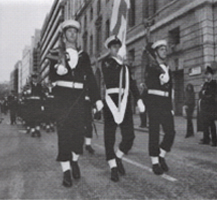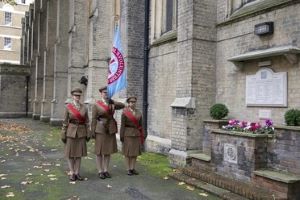Following the formation of the Territorial Force in 1908, permission was granted for Infantry Battalions and Yeomanry Regiments to carry Colours and Guidons, but only under certain conditions.
If an Infantry Battalion elected to carry Colours then first there was a requirement to relinquish the uniform, customs and title of a Rifle Regiment.
In addition, only Yeomanry Regiments-styled ‘Dragoons' would be permitted to carry a Guidon as sanctioned for Dragoon Regiments of regular cavalry.
It was made clear from the beginning that the expense involved in the provision of Colours would not be available from public funds, the Army or the Territorial Force Associations. The expenses involved would have to be covered by the Regiment or paid for by funds ‘gifted' by friends of the Regiment.
This certificate was produced by the 7th Bn Duke of Cambridges Own (Middlesex Regiment) TF in recognition of the fundraising effort by the Ladies of Hornsey in order to pay for the new battalion colours.
The appeal was led by the Mayoress of Hornsey in 1909 and the certificate lists the names of every lady who contributed.
The certificate still hangs in the Officers Mess at ARC Priory Road Hornsey that was until 1958 the Battalion Headquarters of the 7th Bn The Middlesex Regiment (DCO) (TA).
The Guidon of the Inns of Court and City Yeomanry with escort outside Lincolns Inn chapel.
The Guidon was presented to the Regiment by HM Queen Elizabeth the Queen Mother to mark the Amalgamation of the Inns of Court Regiment and City of London Yeomanry in 1961.
Colour Party of the London Regiment at the Regiments presentation of Colours at the Duke of York’s HQ in 1993. The members of the Colour Party represent the Regiments 4 Cap Badges. The colours of the London regiment are unique in that there are no Battle Honours displayed on either the Queen’s or the Regimental Colour displays no Battle Honours. These colours will be replaced and laid up after 25 years of service unlike most of the Colours that were presented in 1909 that were not replaced in many cases until until the reorganisation of the TA in 1960.
Kings Colours of the War Raised battalions of WW1
On December 2nd 1918 General Routine Order 5734 announced that His Majesty King George V was graciously pleased to approve that war raised Battalions of the Regular Army and Territorial Force (Rifle Battalions excepted) would be presented with a silk Union Flag.
The distribution of the Flags began December 1918. They were machine made and the pikes had a plain Spear Head Finial rather than the usual gilt Royal crest. The Flags were plain but any Battalion was free to add its titles and number (and later battle Honours) at unit expense.
Army Council Instruction No 444 of the 21st Julys 1919 stated that His Majesty The King commanded that as the Flags would represent the Kings Colour they should now be presented and consecrated and as such would be granted the usual salutes and compliments authorised to be paid to Colours
By the time the presentation and consecration of the Colours took place, most of the Battalions concerned had been disbanded and the formal laying up of each Colour followed almost immediately.
The laying-up of the King's Colour of the War Raised 2nd Battalion of the 19th (County of London) Battalion The London Regiment (St Pancras) at St Pancras Church, Euston Road, Bloomsbury on the 6th December 1925.
Colours carried by the of the RNR, RMR and the RAuxAF
The terms of issue of colours to units of the Royal Naval Reserve, The Royal Marines Reserve and the Royal Auxiliary Airforce differ from that of the Army Reserve and its predecessors although no different from their regular arm of service with the exception of the Royal Marines Reserve.

In issue of a sovereigns Colour for use by the Royal Navy was sanctioned by HM King George V in 1925.
The queen’s Colour is a white ensign of silk with a crown and Royal Cypher imposed queens’ colour is issued to every command and branch within the Royal Navy. It is a naval tradition the Battle Honours are added to a ships Honours Board and not to the Queen’s Colour,
The picture shows the Queen’s Colour of the Royal Naval Reserve held by HMS PRESIDENT.

In 1951 Colours were carried representing the three remaining Royal Marine Divisions; Chatham, Portsmouth and Plymouth.
In 1949 a working party had been formed tasked with submitting proposals for the future carrying of Colours bearing in mind the post war organisation of the Corps. The main recommendations from the working party were that the three remaining post-war Commando units should now carry Colours taking over from what had previously been the preserve of the 3 Royal Marine Divisions.
The Royal Marines Volunteer Reserve Centres of which there were four located in the City of London, Glasgow, Bristol and Merseyside would not be issued with Colours as they were essentially peacetime training units.
Royal Marine Colours carry only one Battle Honour 'Gibraltar'.
The Protocol of presenting Standards to the Squadrons of the RAuxAF is the same as the Standards presented to the Squadrons of the Royal Air Force.
The basic requirement for a squadron to receive a Standard is completion of 25 years’ service. However, a Standard might be issued to a squadron which ‘earned the sovereigns appreciation for especially outstanding operations’. Squadron Standards may display a maximum of eight Battle Honours.
Colours of Auxilliary Units within Greater London
The four Auxiliary units with Colours that have served or continue to serve the military or civic authorities within Greater London are the First Aid Nursing Yeomanry (Princess Royals Volunteer Corps) Founded in 1907, The Legion of Frontiersmen founded in 1902 the Woman’s Volunteer Service Founded in 1914 and disbanded in 1918 and City of London National Reserve founded in 1915 and disbanded at the end of the Great war
The origins and reasons for these organisations carrying their own Colour, is the same in principle as that of the Standards. Guidons and Colours of military forces of the realm. However, both the design of the Banner and the finial are a matter for the organisation concerned. The Colours of the Auxiliary organisations are usually presented, dedicated and eventually laid-up in formal ceremonies similar to those appropriate to the Military forces of the realm.
The purchase of such colours is the responsibility of the organisation concerned.
The Colour Party of the Fist Aid Nursing Yeomanry ( Princes Royals Volunteer Corps) beside the Unit War Memorial at St Pauls Church Wilton Place Knightsbridge.
The design and purchase of banners for Auxiliary organisations and the formalities and responsibilities in holding a standard are a matter for the unit.
The Register Of Laid-up Colours of Reserve Force units in Greater London
All Standards, Guidons and Colours are the property of the State. Colours once laid up are intended to remain where deposited in perpetuity. The regulations for all Kings colours apply to all Standards, Guidons and Colours once laid up and are enshrined in Queen’s Regulations Chapter 8.038.
When Colours are deemed completely disintegrated , the remains are to be buried with the staff and finial in consecrated ground without any marking in accordance with Queen’s Regulations Chapter 8.032.
The following register of Colours that have been laid up, and most of which may still be seen, includes that of the Drake Battalion of the London Division of the RNVR as well as the Standards of 600 (City of London) Squadron, 601 (County of London) Squadron and 604 (County of Middlesex) Squadron, all presented in 1952.
All the Colours, Guidons and Standards displayed were originally presented to Units with HQ locations within the Greater London area.
Note:

 zoom_in
zoom_in zoom_in
zoom_in zoom_in
zoom_in zoom_in
zoom_in zoom_in
zoom_in
 zoom_in
zoom_in